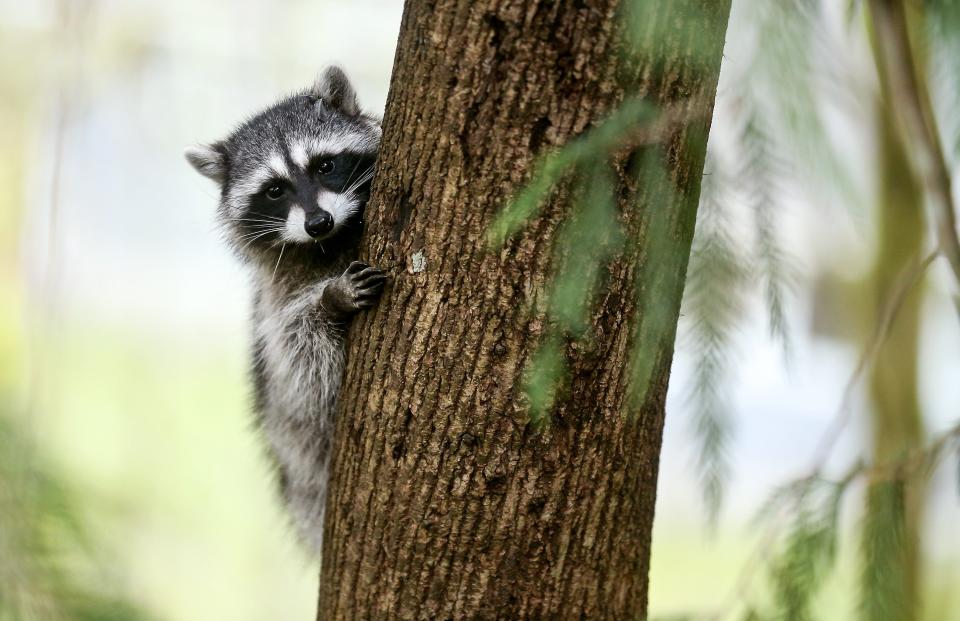Rabies incident in Delaware Water Gap was just third in a dozen years
LEHMAN, Pa. − The attack of a rabid raccoon on a human earlier this month was just the third such encounter reported in the Delaware Water Gap National Recreation Area in the past dozen years, according to a park officials.
Dani Cessna, chief of interpretation and education for the 70,000 acre park, spoke to the media Friday afternoon at the Bushkill Access ramp on the Pennsylvania side of the Delaware River. She said the 66-year-old man who was bitten by a raccoon has begun rabies treatment.
The man was walking on the McDade Trail, a walking-biking trail which follows the western side of the river beginning at Hialeah Recreation Area on the south and traveling north to Milford Beach.
The Bushkill Access is about 10 miles from Hialeah and the McDade Trail runs through the access area then heads northward to Valleyview group campground just under a mile north.
After being bit, the man was able to immediately call the park's communications center (either by 911 or directly at 570-426-2457). Responding law enforcement officers were able to find the raccoon which had not moved too far from the spot where the man was bitten.
Cessna said the rangers were able to euthanize the raccoon and get the body to a pathology lab which took samples which tested positive for the rabies vaccine.
She noted that the only way to test an animal for rabies is by examining the animal's brain tissue which, obviously, requires the animal to be euthanized.

With the exception of opossums, all mammals are susceptible to the virus. However, birds, such as crows, ravens or vultures, do not get rabies, which is always fatal. Because those birds and opossums scavenge the bodies of mammals which have died of rabies, the disease seldom spreads from a dead animal.
Cessna said hikers, bikers and even people paddling on the river, should be alert to animals which are acting unusual.
In fact, in 2012, a paddler on the river was bitten by a beaver which was determined to be rabid. There was another reported case of a rabid animal in the park in 2019.
That animal was also a raccoon. Distantly related to cats and dogs, raccoons share a common evolutionary ancestor with bears, and are very adaptive and among the more intelligent mammal species.
Before the 1990s, rabies in raccoons was nearly non-existent in the northeast with the disease mostly confined to other wildlife, most often bats, skunks and canines such as foxes and coyotes.
But in the 1990s, a strain of rabies spread northward. Unlike household dogs and cats which can be taken to a veterinarian, raccoons are wild, so state and federal wildlife agencies began dropping vaccines in food pellets from airplanes and helicopters over wooded areas. While they don't gather in packs, such as wolves, raccoons are friendly with other raccoons.
Signs of rabies
However, like most wild animals, raccoons are generally "unseen" by humans.
And, according to Cessna, that is strong evidence there is something wrong with any wild animal which seems unafraid of humans, or approaches you.
In latter stages of the disease, the victim often drips saliva from their mouth, giving the impression of "foaming at the mouth." They may also be aggressive, seemingly walk in circles and show other signs of strange behavior.
Cessna also noted that this is springtime, with wildlife rearing young. However, she noted, there is a difference in behavior between a mother protecting her den, and a fox or raccoon which has no fear of humans and could have the rabies virus.
That is why, she said, anyone out hiking or walking with a pet must keep the animal on a leash and under control. A dog could run off, encounter a rabid animal, get bit or scratched, and the rabies virus gets transmitted. Once the virus takes hold, the animal must be euthanized.
In the U.S., there are 1-3 rabies deaths in humans each year, but there are more than 60,000 encounters with rabid animals with the people getting post-exposure prophylaxis (PEP) each year to prevent rabies infection after being bitten or scratched by an infected or suspected infected animal.
According to the federal Centers for Disease Control, when an animal is bitten or even nipped by a rabid animal, the rabies virus from the infected saliva enters the wound. The virus takes from three to 12 weeks to get to the spinal cord and brain during which the infected animal has no signs of illness.
Once the virus reaches the brain, however, things move along quickly as the virus multiplies and passes into the salivary glands. The animal begins to show signs of the disease, such as aggressiveness, no fear of humans. Bats may be in a house and bite a sleeping person.
Once in the blood, the virus travels into the nerves and into the spinal cord and on to the brain. This process can last weeks. The animal has no signs of illness during this time.
Once in the brain, the virus multiplies rapidly and passes to the salivary glands and at the same time, begins to show signs of the disease. At that point, the infected animal usually dies within a week.
The CDC said early signs of rabies are general sickness, problems swallowing and then excessive drool or saliva. Symptoms grow into the animal being overly aggressive, often "bites at imaginary objects" or even appears tamer than you would expect from a wild animal.
Stay away from an animal that's having trouble moving or appears to be paralyzed and do not handle a bat that is on the ground.
The CDC also notes that more than a third of all animals confirmed to have rabies are raccoons.
This article originally appeared on New Jersey Herald: Rabies incident at Water Gap was just third in a dozen years

